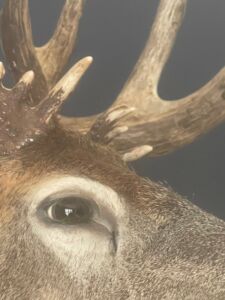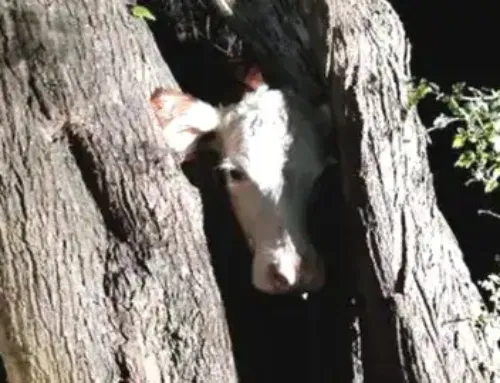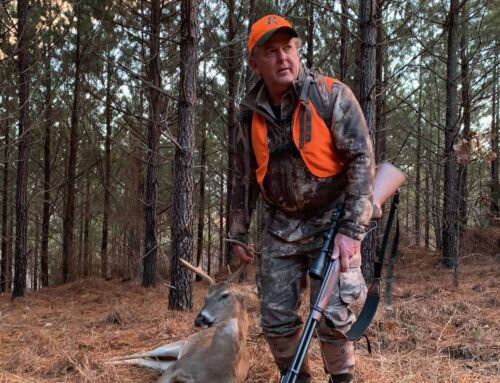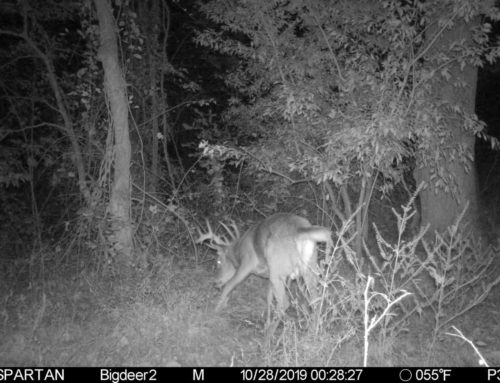 The 10-pointer stepped out of the brush, took a quick look around, lowered his head and strolled toward the corner of the bean field. I smiled and put tension on the bowstring. The wind was perfect for where I was sitting, and in less than a minute the buck’s route would take him down a shallow funnel and to a place less than 25 yards below my tree stand.
The 10-pointer stepped out of the brush, took a quick look around, lowered his head and strolled toward the corner of the bean field. I smiled and put tension on the bowstring. The wind was perfect for where I was sitting, and in less than a minute the buck’s route would take him down a shallow funnel and to a place less than 25 yards below my tree stand.
He kept coming, nose to the ground, but 40 yards out he stopped, flinched, peeked up and wheeled back into the cover. What the…? Had I moved a muscle? I didn’t think so. All I knew was that the buck was gone, and I was I left to wonder went wrong, and to marvel at the uncanny vision of a whitetail buck.
Early Research on Deer Vision
The first studies decades ago found that deer have a higher density of rods in their eyes than cones. Rods are highly sensitive to light, but not as sensitive to color. And so deer have better nighttime vision than we do, but poorer daytime and color vision.
Subsequent research in the 1990s at the University of Georgia found that the high number of rods in a deer’s eye also serve as the ultimate motion sensors, allowing the animals to detect even the slightest hint of movement. Then, in an effort to identify a strange object that might present danger (like you or me), the researchers observed that a deer shifts its head from side to side, moves it up and down and stares from several different angles. The dreaded head bob!
Over the years, several researchers have pointed out that deer have horizontal pupils, and those pupils open wide to gather maximum light. Combine this with the fact that a deer’s eyes are positioned on the sides of its head, and an animal sees with a wide field of view, further allowing it to pick up movement in low-light conditions.
Subsequent Science
Just how far to the left or right can a deer see? According to a study of animal vision at UC-Berkeley a decade ago, a deer’s eye positioning and pupils allow for an amazing 300-degree panoramic view of the surroundings! (For comparison, your field of view is less than 180 degrees.) To cover the 60-degree blind spot in the back, a deer simply turns its head slightly left or right to eyeball things. The old saying when a hunter gets busted, “That buck must have had eyes in the back of its head!” is about right.
If you thought that was interesting, this will blow your mind. According to Marty Banks, Professor of Optometry and Vision Science at UC-Berkeley and lead man on the aforementioned study, a deer’s eyes can rotate independently in different directions to maintain alignment with the horizon.
“If you imagine a line coming out of the center of the animal’s eye, the eye is spinning around that line,” Banks told the QDMA. “So when an animal pitches its head down, the left eye has to rotate clockwise, and the right eye has to rotate counterclockwise. We think we can see each eye rotating about 50 degrees. One is going 50 degrees and the other is going minus 50 degrees, so the difference is about 100 degrees. It’s a pretty remarkable ability.”
It’s called “cyclovergence,” or when the eyes rotate in different directions. For deer, cyclovergence keeps the horizontal bands of vision in each eye aligned and level with each other, maintaining the deer’s panoramic view of its surroundings even while its head is tilted downward at ground level to feed, or perhaps when a buck is walking sniffing on a doe trail.
Bottom line: Cyclovergence allows a deer to maintain the wide view and motion-detecting benefits of side eyes and horizontal pupils, whether it’s scanning the woods, walking or standing still with head down and feeding or smelling.
How to Beat a Buck’s Eyesight
The research points to one thing you already know: movement. If you shift your body or to draw your bow at the wrong time a deer will bust you and break your heart. When a buck or doe comes in from left or right, looks your way and picks you out as potential trouble, freeze. Do not move a muscle. When the animal appears to have calmed down, keep still! He or she might try to fake you out a few times…head bobbing and stopping…bobbing and stopping…
Often an old doe will do some head bobbing and then turn her head and look off to the side or away from you—don’t move because remember, she is still looking at you out the corner of her eye, trying to make you move first. Only when the head bobbing and weaving stops for good and the deer relaxes and seems satisfied that you are not dangerous should you shift in your stand or get ready to draw your bow. This might take 20 seconds or several minutes, so don’t move too soon and get busted.
Researchers say a deer’s eyes are most oriented to pick up predator movement at or just below the horizon. They say you can get away with more movement in a tree stand than on the ground.
Maybe…
But when a buck is 100 yards out and coming on a string to your stand be careful. Deer not only have a super-wide field of view, but as we have noted, their eyes are built for picking up the tiniest flicker of movement. When a deer is boring in, freeze. Best is to shift and move only when its eyes go behind a tree or cover. Sometimes if the woods are open, I’ll let a buck walk tight below my stand, then move. Nerve-racking for sure, but a deer usually will not crane its head way back and look straight up, unless you bang the stand with your boot or do some other foolish thing.
Finally, remember that strange thing call cyclovergence. Just because a buck drops its head to feed or sniff the ground, that doesn’t automatically mean it is all clear to stand up or draw your bow. His eyes are still spinning and looking! Be super careful, watch the deer and move when you can, preferably when his head is hidden by a tree or cover.






Leave A Comment